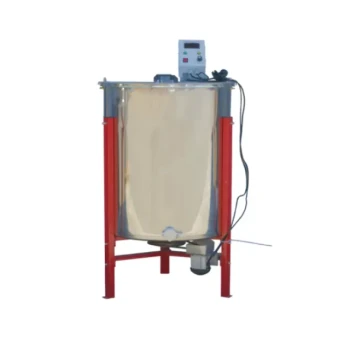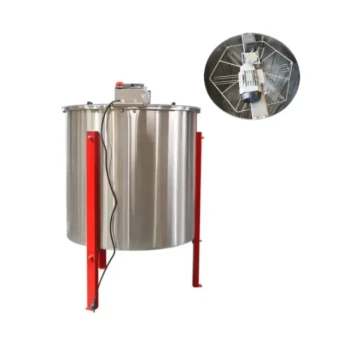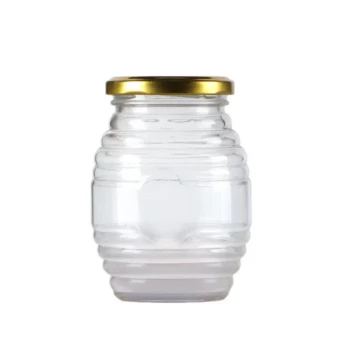The most common methods to decrease moisture in honey involve gentle heating, increasing the honey's surface area, and using dehumidifiers to circulate dry air. These techniques work by encouraging water to evaporate from the honey until it reaches a stable moisture content, typically below 18%, which prevents fermentation and preserves its quality.
The core challenge is that excess water activates naturally present yeasts, causing honey to ferment and spoil. Reducing the moisture content to below 18% is the essential step to ensure your honey remains stable, flavorful, and preserved for the long term.
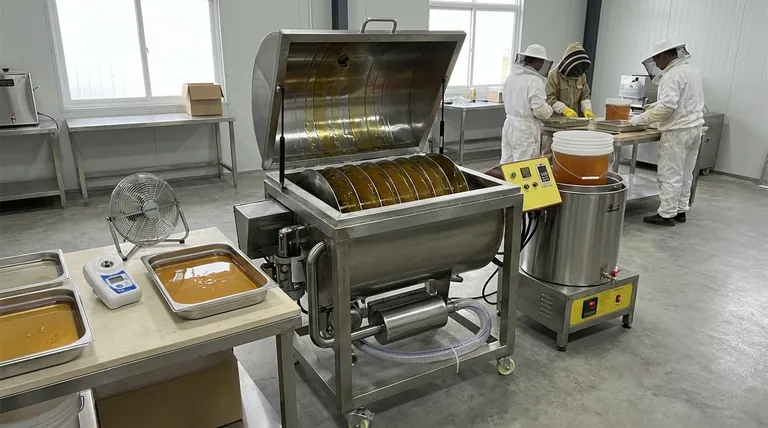
Understanding Why Moisture Content is Critical
Before applying a solution, it's vital to understand the problem. The moisture level in honey is the single most important factor determining its shelf life and quality.
The Fermentation Threshold
Honey with a moisture content above 19-20% is at high risk of fermentation. Naturally occurring yeasts can become active in this environment, turning the sugars into alcohol and carbon dioxide, spoiling the honey's flavor and aroma.
The ideal moisture content for long-term storage is between 17% and 18%. At this level, the high sugar concentration creates an environment where yeast and other microbes cannot survive.
Common Causes of High Moisture
High moisture isn't a mistake; it's usually a result of environmental conditions. Key causes include harvesting honey too early before the bees have had a chance to dehydrate it, extended periods of wet or humid weather during the nectar flow, or accidental introduction of water during extraction.
How to Accurately Measure Moisture
You cannot manage what you don't measure. The standard tool for this task is a honey refractometer. This simple device provides an instant and accurate reading of the moisture content, allowing you to know precisely where your honey stands and when it has reached the safe zone.
Proven Techniques for Lowering Honey Moisture
Several methods exist, ranging from simple setups for hobbyists to advanced equipment for commercial operations. The principle behind all of them is encouraging evaporation.
The Dehumidification Method
This is one of the most popular and gentle methods for small-scale beekeepers. It involves placing open containers of honey in a small, sealed room with a powerful dehumidifier and a fan.
The dehumidifier pulls moisture from the air, creating a very dry environment. The fan circulates this dry air across the surface of the honey, which pulls the water out. This process can take several days but is highly effective.
The Gentle Heat Method
Applying gentle heat reduces honey's viscosity (making it thinner) and speeds up water evaporation. This is often done with tools like bucket heaters or in warming cabinets.
The key is controlled, low heat. Aggressive heating can damage the honey's delicate enzymes and flavors.
Increasing Surface Area
The more honey surface is exposed to dry air, the faster it will dehydrate. This principle can be used on its own or combined with the methods above.
Commercial systems use rotating discs, cones, or wire mesh to create a thin film of honey, dramatically increasing the surface area and speeding up the drying process. For a hobbyist, simply using wide, shallow pans instead of deep buckets will help.
Specialized Commercial Equipment
For larger operations, dedicated honey dryers or vacuum-based systems are used. A honey dryer often works on a condensation principle, circulating warm, dry air over the honey and then cooling the now-moist air to condense the water out before reheating and recirculating it.
Vacuum systems allow water to be evaporated at very low temperatures, which is excellent for preserving the honey's most delicate qualities.
Understanding the Trade-offs and Risks
While reducing moisture is necessary, the method you choose has consequences. Being aware of the potential downsides is critical for maintaining high-quality honey.
The Danger of Overheating
This is the most significant risk. Heating honey too much or too quickly will destroy beneficial enzymes like diastase and invertase and can produce undesirable compounds like HMF (hydroxymethylfurfural). It can also darken the honey and alter its delicate flavor profile.
The Time Commitment
The dehumidification method is very safe for the honey but is not fast. It can take several days to lower the moisture content by just a few percentage points, requiring a dedicated space and patience.
The Risk of Contamination
Any time honey is left exposed to the air for long periods, there is a risk of it absorbing ambient odors or collecting dust. The drying area must be clean, sealed, and free of strong smells.
Making the Right Choice for Your Goal
Your ideal method depends entirely on your scale, budget, and priorities.
- If your primary focus is preserving raw qualities on a small scale: The dehumidifier and fan method in a clean, sealed room is your best option, as it protects the honey's delicate enzymes and flavors.
- If your primary focus is speed for a medium-sized batch: Using a controlled warming tank or bucket heater is effective, but you must monitor the temperature carefully to avoid overheating and damaging the honey.
- If your primary focus is consistency and volume for commercial processing: Investing in a purpose-built honey dryer or vacuum dehydrator is the only way to achieve reliable results while protecting quality at scale.
Ultimately, managing moisture correctly is the final, crucial step in stewarding your honey from the hive to the jar.
Summary Table:
| Method | Best For | Key Consideration |
|---|---|---|
| Dehumidification | Preserving raw honey quality | Gentle but slow; requires a sealed room |
| Gentle Heat | Medium-scale batches needing speed | Risk of overheating and damaging enzymes |
| Commercial Dryers | Large-scale, consistent processing | Highest equipment cost but best for volume |
| Increase Surface Area | Enhancing any other method | Use wide, shallow containers or specialized film systems |
Need reliable equipment to manage honey moisture at scale?
As HONESTBEE, we specialize in supplying durable, commercial-grade beekeeping supplies and equipment to commercial apiaries and distributors. Whether you need accurate refractometers, efficient warming cabinets, or high-capacity honey dryers, our wholesale-focused operations ensure you get the right tools to protect your honey's quality and profitability.
Contact our experts today to discuss your specific needs and secure your equipment.
Visual Guide
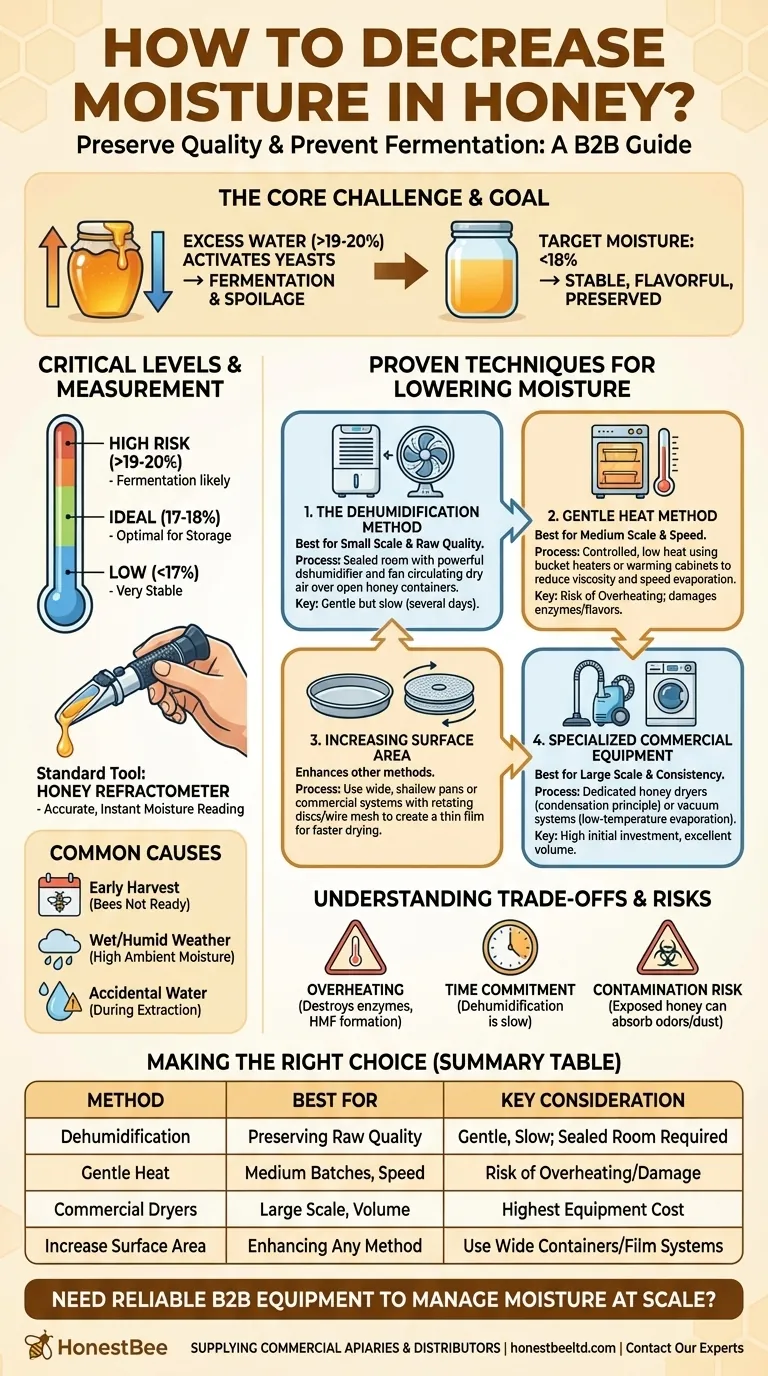
Related Products
- Economy Small Scale Honey Dryer Dehumidifier Thickening Machine
- Honey Concentrating and Filtering Dehumidifier Machine 2T Capacity for Honey
- Stainless Steel Triangle Support Honey Strainer and Filters
- HONESTBEE 72 Frame Industrial Electric Honey Extractor for Beekeeping
- Electric 8 Frame Honey Spinner Extractor Equipment for Beekeeping
People Also Ask
- How to reduce moisture level in honey? Preserve Quality and Prevent Fermentation
- What are some tips for preventing excess moisture in honey during harvesting? Essential Steps for a Stable Harvest
- How does temperature regulation help in managing honey moisture content? Prevent Fermentation & Ensure Quality
- How can the moisture content of honey be reduced? A Guide to Safe, Effective Drying Methods
- How does a honey dryer remove moisture from honey? Achieve Perfect Honey Stability with Controlled Drying






